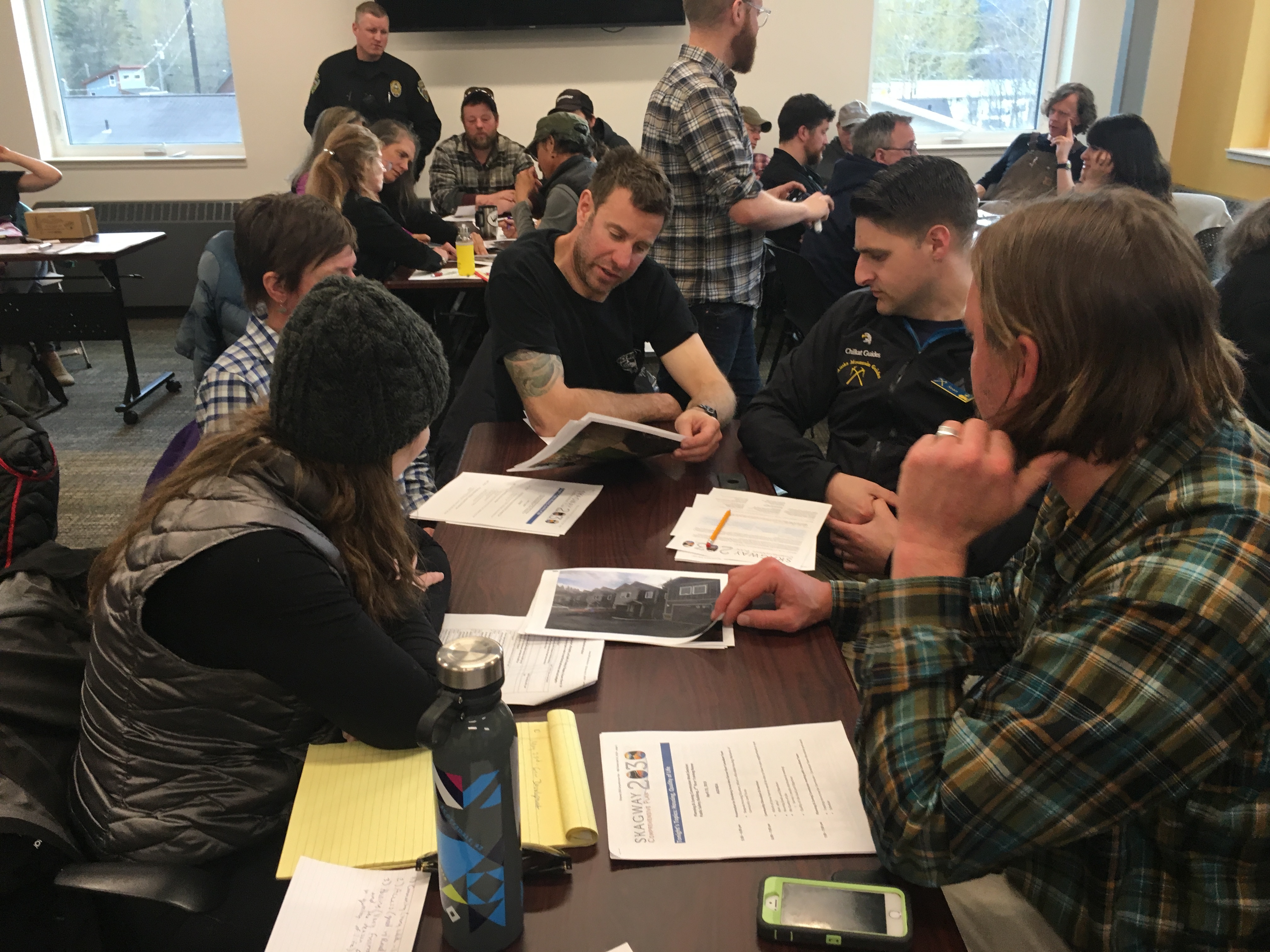- Community
- Business
-
Government
-
- Mayor and Assembly Boards and Commissions Municipal Code Meetings Directory Public Notices Employment Elections Port of Skagway
- Departments Manager & Administration Finance Borough Clerk’s Office Dahl Memorial Clinic Skagway Visitor Department Skagway Volunteer Fire Dept. Small Boat Harbor Library Museum Parks & Recreation Police Department Port of Skagway Public Works Recreation Center Water Department
- Quick Links COVID-19 Information Land Parcel Viewer FY24 Budget 2023 Property Assessment Roll Water Quality Report Audio for Municipal Meetings Municipal Code Public Records Request Forms Ordinances Resolutions Documents Assembly Live Stream
-
- Resources
April Meeting Summary: Quality of Life & Housing
Along with Planning and Zoning Commissioners, about 35 residents gathered on April 25 to discuss quality of life and housing in Skagway.
Upon arriving, participants were asked to rate their quality of life in Skagway and to share three things that are important to their quality of life. While response were written and will be tallied later, a few residents shared that important aspects of quality of life are the sense of community in Skagway, access to green space, recreation opportunities, and a sense of a stable future. The group also learned about some of the themes regarding quality of life emerging from surveys and interviews; these themes include: people, beauty, opportunity, families, attitude, small town, and history.
Next, there was a presentation on what housing affordability means in Skagway, learning along the way that to afford to buy the median priced home in Skagway ($250,000-$336,000) without becoming cost-burdened (more than 30% of income), a buyer must earn approximately $59,000-$75,000 per year. Additional analysis of the current situation in Skagway revealed more conclusions, including that generally:
- There must be two wage-earners in a household in order to afford to buy the median priced home
- Thus, there is a need for childcare in order to be able to afford to own a home
- Approximately 60% of households in Skagway can afford to buy a median priced home while 40% cannot
Participants then discussed future residential needs and possible housing designs to address these needs and the fit of options in Skagway. Some of the available municipally-owned parcels that could accommodate additional residential construction include the newly acquired 15 acres (5 slated for housing) at the Dyea Road turnoff, the former Garden City RV Park, and the site of the old health clinic. After comparing the geometry and acreage of these sites to residential developments in other communities, participants divided up into small groups to look at pictures of denser housing and discuss: 1) what do you think you are looking at, and 2) is there a place for this type of housing in Skagway? The examples discussed are (see attachment):
- Deed-restricted townhomes (must live in county and work there at least 30 hr/week year round) on city-owned land in Vail, Colorado
- A four-unit single-room-only (SRO) apartment building in Sitka that replaced a single family home in downtown.
- A four-unit condominium building that looks like a single family home in downtown Juneau
- A permanently affordable housing unit on community land trust land at Lena Point, Juneau, built through a partnership with high school and UAS as part of vocational training.
- Fifteen detached condominiums on about 2 acres in Juneau’s Mendenhall Valley (3 BR, garages, 1450 sf, selling in mid-$300,000 range)
- A permanently affordable housing unit on community land trust land in Sitka
- A 11-unit cottage home development (condominium) with shared green space and a community building on 1 acre in Bainbridge Island, Washington
- A Multifamily housing complex on Bainbridge Island, Washington
- Subsidized affordable apartment complex in Juneau, about 73 units that are a mix of 1-3 BR
- Permanently affordable housing units on community land trust land in Juneau.
Most participants agreed that each of these types of residential options probably have a place in Skagway while reservations were articulated about the modern aesthetic of some of them.
Finally, the group was introduced to tools that the Municipality of Skagway can deploy to encourage the development of more and more affordable residential unity, including:
- Zoning and permitting
- Property tax abatement
- Deed restrictions to accomplish community housing goals
- Subsidize land and infrastructure
- Support a community land trust
- Low interest loans or grants for development or for purchase
Final thoughts and reactions from the gathered participants included:
- The need to consider sewer capacity as this informs what type of concepts are possible
- The need to find the right mix of concepts and locations to increase affordability to retain residents
- That single family units might be too expensive
- The need to address short term rentals
- The high appeal of dwellings out of the town site and need for land to support this to some residents. This includes both lots for higher end single family homes and smaller lots for “dry cabin” living.
The work session was part of the ongoing Skagway 2030 Comprehensive Plan process, which encourages community members to share their aspirations and concerns. The next opportunity to get involved is:
- Thursday, May 23, 5:30–7:30 pm, Public Safety Facility Training Room, Topic: Economic Development
More work sessions are planned on the fourth Thursday of most months to explore community priorities around transportation, public services and facilities, and natural and cultural resources.

